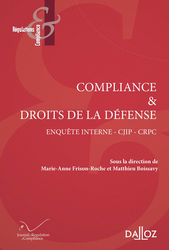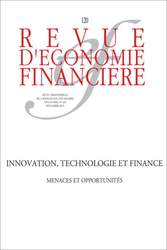Jan. 17, 2024
Thesaurus : Doctrine

► Référence complète : J.-F. Bohnert, "Les conditions de réussite de l'enquête interne dans les rapports entre le Parquet national financier et l’entreprise mise en cause – l’enquête interne au soutien de la défense de l’entreprise", in M.-A. Frison-Roche et M. Boissavy (dir.), Compliance et droits de la défense. Enquête interne – CJIP – CRPC, Journal of Regulation & Compliance (JoRC) et Dalloz, coll. "Régulations & Compliance", à paraître.
____
📕consulter une présentation générale de l'ouvrage, Compliance et droits de la défense - Enquête interne, CIIP, CRPC, dans lequel cet article est publié
____
► Résumé de l'article (fait par le Journal of Regulation & Compliance - JoRC) : Dans sa contribution, le procureur national financier rappelle qu'il s'est exprimé sur sa conception des enquêtes internes dans des lignes directrices et guide, document qui ne "décrivent une pratique et répondent à des objectifs de transparence et de prévisibilité pour le public et les acteurs économiques". Il estime qu'une entreprise confrontée à une suspicion d'infraction doit arbitrer sur l'opportunité de lancer une enquête interne, afin notamment de se réorganiser. Si cette démarche contribue à la manifestation de la vérité, elle sera valorisé dans les éventuelles procédures ultérieures.
Il faut que les conditions et procédures de l'enquête soient satisfaisantes, notamment dans la recueil des informations, les garanties procédurales offertes aux personnes, la rédaction du rapport d'enquêtes. Si celui-ci révèle des "comportements non conformes aux procédures établies en interne", l'entreprise pourra en tirer les conséquences judiciaires et/ou disciplinaires. L'auteur souligne que l'analyse doit être menée indépendamment de l'écriture du rapport pour ne pas biaiser la présentation des faits.
Il est rappelé que les lignes directrices invitent l'entreprise à informer spontanément le PNF des faits révélés par l'enquête, ce qui permet ainsi à l'entreprise à prétendre à une "réponse pénale négociée et adoucie" en raison de cette "attitude de coopération et de bonne foi" et du "sérieux" des investigations menées, tandis que le PNF mène une enquête pénale. Le PNF pourra d'ailleurs demander à avoir communication des rapports d'exécution, lettres de mission, etc., de l'enquête interne. En revanche, une enquête interne "défensive", par exemple ouverte après l'ouverte de l'enquête pénale, pourrait être contreproductive. Une collaboration peut à l'inverse s'instaurer, le PNF pouvant propose un document de cadrage d'une enquête interne, un calendrier, etc. , ce qui peut se traduire par des liens continus entre le PNF et l'entreprise tout au long de l'enquête interne. Le PNF considère que si des avocats interviennent dans ce cadre, ils devront être différents de ceux qui interviennent dans l'instance pénale, parallèle ou ultérieure.
____
🦉Cet article est accessible en texte intégral pour les personnes inscrites aux enseignements de la Professeure Marie-Anne Frison-Roche
________
Sept. 22, 2020
Newsletter MAFR - Law, Compliance, Regulation

Full reference: Frison-Roche, M.-A., Interregulation: way of "cooperation protocol" between Regulatory Bodies. Example between French Financial Markets Authority and Anticorruption Agency, Newsletter MAFR - Law, Compliance, Regulation, 22nd of September 2020
Read by freely subscribing other news of the Newsletter MAFR - Law, Compliance, Regulation
Summary of the news:
Although Regulation Law was born from the notion "sector", constant interferences between sectors and frequent interactions between some sectors and more general questions common to different sectors, make interregulation necessary. Compliance Law being the extension of Regulation Law, this interregulation mechanism is also necessary in Compliance Law.
This interregulation can take many legal paths like letters exchanges between regulators, the creation of a network of regulators and supervisors at the world level or about some specific question or the adoption of a "cooperation protocol" as the AMF (French Financial Market Regulator) and the AFA (French Anticorruption Agency) did on 16th of September 2020 to reinforce their respective fight against corruption, against market abuses and for the protection of investors.
This cooperation protocol between the AFA and the AMF has the following subjects:
- A more efficient methodology concerning the research and the analysis of corruption and market abuses.
- A more efficient prevention of corruption and market abuses.
- A better capacity to give recommendations of new regulations to the Legislator.
- A more rigorous monitoring of international works on the topic.
- A more coherent information for the public.
Are regulators the new teachers?
Sept. 2, 2020
Newsletter MAFR - Law, Compliance, Regulation

Full reference: Frison-Roche, M.-A., Compliance & Regulatory Soft Law, legal Certainty and Cooperation: example of the U.S. Financial Crimes Enforcement Network new Guidelines on AML/FT, Newsletter MAFR - Law, Compliance, Regulation, 2nd of September 2020
Read by freely subscribing other news of the Newsletter MAFR - Law, Compliance, Regulation
Summary of the news
The Financial Crimes Enforcement Network (FinCEN) is an organ, depending on the American Treasury, in charge of fighting against financial criminality and especially against money laundering and terrorism financing. For this, it has large control and sanction powers.
In August 2020, the FinCEN published a document untitled "Statement on Enforcement" which aimed to explicit its control and sanction methods. It reveals what firms risk in case of offense (from the simple warning letter to criminal pursuits passing through financial fines) and the different criteria on which FinCEN is based to use one sanction rather than another. Among these criteria, we find for examples the nature and the seriousness of committed violations or the firm's history but also the implementation of compliance program or the quality and the spread of the cooperation with FinCEN durning the investigation.
One of the objectives of the publication of such an information document is to obtain the cooperation of firms by creating a confidence relationship between the regulator and the regulated firm. However, it is very difficult to ask to the firms to cooperate and to furnish information if they can fear that this same information can be used later as proof against them by the FinCEN.
Another objective is to reinforce legal security and transparency. However, the FinCEN's declaration does not seem to commit it, because it is not presented as a chart but as a simple declaration. Indeed, the list of the possible sanctions and the criteria used by the FinCEN are far from being exhaustive and can be completed in concreto by the FinCEN without any justification.
Aug. 18, 2020
Newsletter MAFR - Law, Compliance, Regulation

Full reference: Frison-Roche, M.-A., Can Coordination between local Regulators replace a unique centralized Regulator? Example of the European organisation of the Open Internet Principle, Newsletter MAFR - Law, Compliance, Regulation, 18th of August 2020
Read, by freely subscribing, the other news of the Newsletter MAFR - Law, Compliance, Regulation
To go further, read Marie-Anne Frison-Roche's article: The hypothesis of interregulation
Summary of the news
The principle of "open internet" enshrined in the European regulation of 30th of April 2016 guaranteeing a non discriminatory access to Internet contents and services. However, there is no European regulator to implement such a principle. Is it possible to guarantee the effectivity of this principle without a central regulator in charge of this principle?
On 11st of June 2020, the BEREC (Body of European Regulators for Electronic Communications) adopted guidelines concerning the application of the open internet principle. The BEREC is not a European regulator but a network of national regulators aiming to coordinate their actions. This body is only a consultative body but its recommendations are taken into account by national authorities which have deep legal power, as Osborne-Clarke said about the technical implementation of the European principle of open internet at the national level.
It is thus non necessary to have a central regulator to ensure the effectivity of a principle since the moment when there is a local regulators network able to coordinate their actions through soft law.
Dec. 13, 2017
Thesaurus : 05.04. Tribunal de Première Instance des Communautés Européennes - Tribunal de Première Instance de l'Union Européenne (Trib.UE)
Dec. 16, 2015
Thesaurus : Doctrine

Référence générale : Verdier, M., Innovation, concurrence et réglementation pour la fourniture de services bancaires en ligne, in Revue d’Économie Financière, Innovation, technologie et finance. Menaces et opportunités, n°120, déc. 2015, p. 67-89.
Les étudiants de Sciences po peuvent lire l'article via le drive dans le dossier "MAFR - Régulation".
Il est remarquable que dans cet article le droit de la concurrence soit perçu et analysé que comme une "réglementation".
Dans cette perspective, il est posé que cette "réglementation" doit s'adapter car pour le développement de l'activité bancaire dans l'espace numérique les acteurs doivent coopérer, ce qui est contraire à la base de la "réglementation concurrentielle".
Pour que les opérateurs innovent, il faut donc mettre le cursus entre la concurrence et la coopération, à la fois dans les relations verticales et entre opérateurs installés et nouveaux entrants.